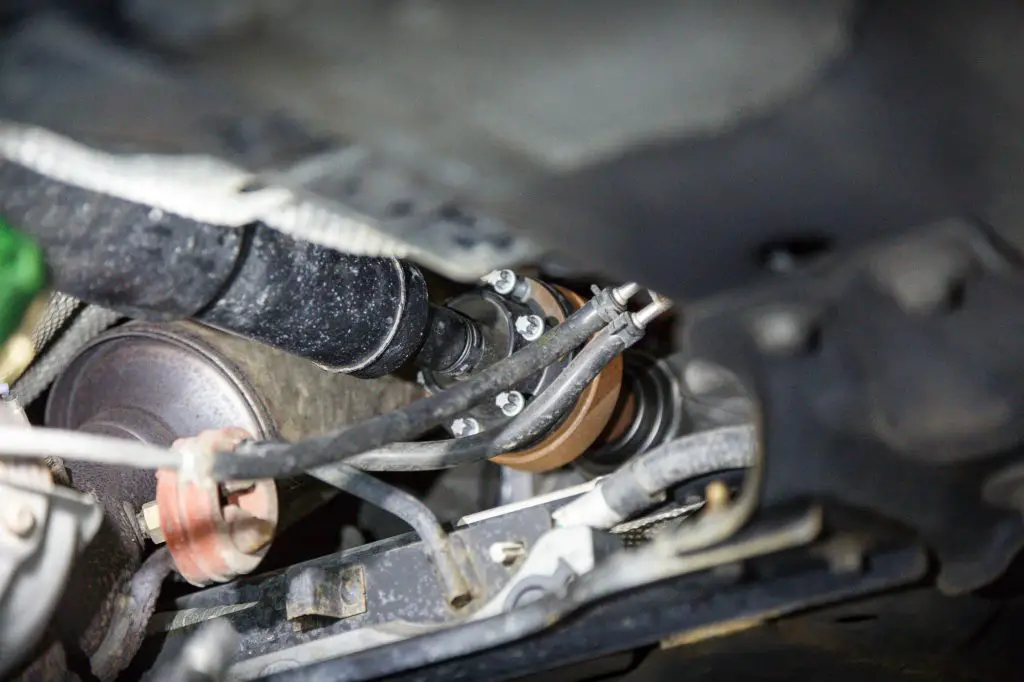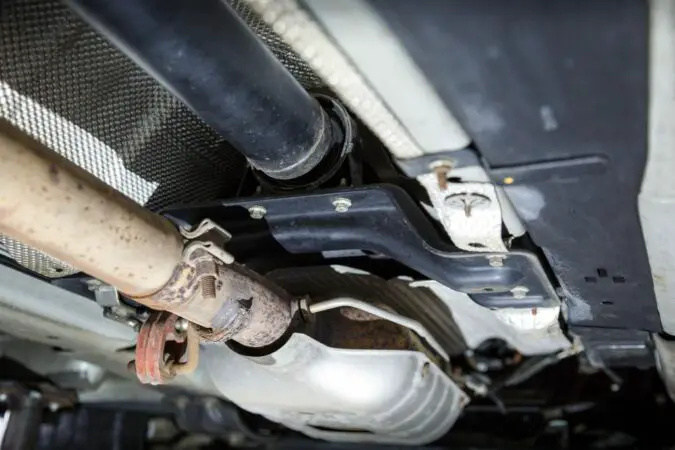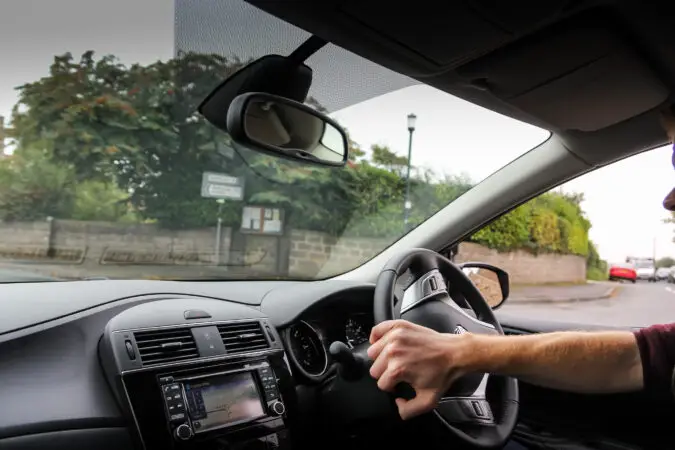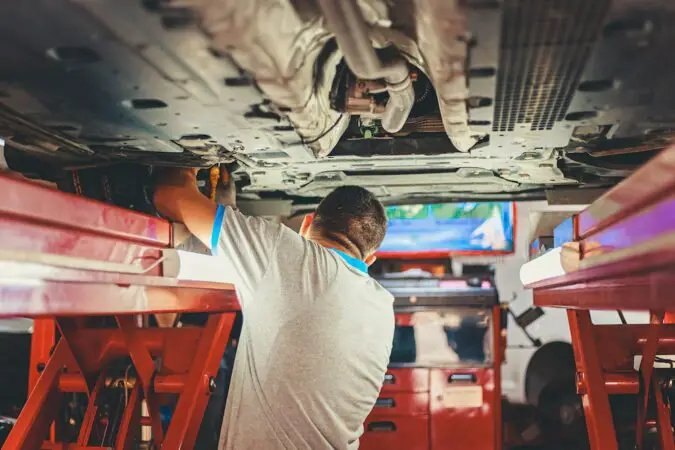Have you ever asked the question what does a driveshaft do? Well, if that is the case and you are in this situation, then you are at the right place because this article will be all about driveshafts and understanding how these components work.
Knowing how components in your car work is a good thing. Why so? Well, mainly because you will be able to tell which component is which. And also, what is most important, you will be able to tell if a component has failed. Like in this case, with the drive shaft.
Why pay thousands of dollars on mechanics when you can get this thing diagnosed and replaced by yourself using common tools? And frankly, a car’s CV axles which are one of the most common driveshafts are really easy to replace. Later on, we will dive into the replacement process and learn how it is done the right way.
But first, we are going to learn what is a drive shaft and what does a driveshaft do on a car. We will understand how this component works and also understand the core principles of this design. Then we will cover the bad drive shaft symptoms and learn what can you expect when it comes to these drive shafts and then we will learn how to diagnose and also how to replace one and at what cost. So, if you want to learn more, please follow along.
What Is A Driveshaft
Now before we dive into more complex topics like what does a driveshaft do, let’s first cover the basics and understand what a driveshaft is in general and also learn a bit about its history. This will be really useful for beginners who want to learn more about the basic idea of a driveshaft and how it looks in general. So, what is a drive shaft?
Well, in simple terms a driveshaft is a big steel circular tube that rotates around itself. This component is also known as a propeller shaft. Or also known as a Cardan shaft. But why Cardan shaft?
Well, the idea about the driveshaft is not something new. This idea was firstly invented by the Italian polymath Gerolamo Cardano. And except in the US and the other English-speaking countries where this component is known as a driveshaft. Elsewhere around the world, this component is known simply as Cardan or Cardan shaft.
The first appearance of the term driveshaft was noted in the mid-19th century. More precisely Stover’s patent that was issued in 1961. This patent was for planning and matching machines. The term was used to refer to a shaft that was belt driven.
But it was up until the 1890s that this term started to be used in a more modern connotation. More precisely the component that connected the transmission and the driving trucks for the Climax locomotive.
But the first company that used a driveshaft in a car was the company Autocar in 1901. A car that nowadays sits in the Smithsonian Museum. So, we learned a lot about the history of the driveshaft. But what does a driveshaft do? Well, more on that we are going to cover next.
What Does A Driveshaft Do
Now let’s move on to the main topic for today. And that is the question of what does a driveshaft do? Let’s elaborate on this question and learn more about it.
So, what does a driveshaft do? As we mentioned previously. The core concept of a drive shaft is about a big steel tube that is connecting two components.
And these two components in the automotive industry are the transmission and the rear differential. Now we are strictly speaking for rear-wheel-drive vehicles that have an engine up front and the moving wheels are at the rear.
This driveshaft is usually located in the center of the chassis. So, this is why you have a big hump in the middle of the car where is the transmission tunnel, starting from the front of the car to the rear. Below this hump is the driveshaft that goes from the front to the back. But what does this driveshaft do?
Well, what it does is that it transfers the rotational torque of the transmission to the rear differential. And then from the differential, this force is transferred to the rear wheels.
As you probably know, the engine is producing power. Thus, helping the crankshaft to spin. Then this rotational force of the crankshaft is transferred to the transmission which then converts it into torque.
Then the torque travels to the driveshaft and rotates the driveshaft. And then from there, the torque is sent to the rear differential and the wheels start to spin. That is the whole drivetrain basically.
FWD cars on the other hand do not have a driveshaft. But something known as CV axle. Which is not technically a driveshaft. Even though a lot of people confuse these two components.
Drive Shaft Diagram
So, we learned more about what does a driveshaft do and learned the core principles. We learned that this is a component that solely has one single purpose and that is to transfer the torque to the rear differential with its rotation. As the driveshaft rotates, it transfers the momentum to the rear differential and this differential then transfers this energy to the wheels.
But have you asked yourself, what components this drive shaft consists of? What are the drive shaft parts, what is the front drive shaft diagram what is the rear drive shaft diagram?
Well, we can tell you that there are no rear and front drive shafts. These are CV axles and not driveshafts. So, why is this so? Well, they directly transfer the rotational energy to the wheel. This means that there is no transmission > driveshaft > differential > wheels. But transaxle or differential > CV axle > wheels. This means that you don’t need a driveshaft for a front-wheel-drive car. The CV axle plays the role of a driveshaft.
But from what components is this driveshaft consists of? Let’s elaborate more on them in the following paragraphs.
Usually, the driveshaft is a single-piece tube. But in some applications, it can be a two-piece mechanism with a central bearing in the middle.
At both ends of the driveshaft, there are universal joints. These joints connect the flange yoke with the fixed yoke. And the universal joints are composed of many small components.
Usually, when a driveshaft fails, these small components in the universal joint fail and start to produce different symptoms that we are going to cover in the following chapters more in-depth and learn what can you expect when these components fail on your car after we covered what does a driveshaft do.
Bad Drive Shaft Symptoms
As we learned what does a driveshaft do, we think that now it is time to learn more about the symptoms of a bad driveshaft.
Knowing the symptoms will be really beneficial for you as an owner because you will be able to tell if your drive shaft is broken or not. What is worth noting is that most often the U-joints fail on these drive shafts and when they fail they start to develop the following symptoms that we will cover.
So, pay close attention and if some of these symptoms resemble one of your problems, you know where to look at.
What Does A Driveshaft Do, Symptoms #1: Problems Turning The Vehicle
So, we learned what does a driveshaft do, now let’s cover the first symptom of a bad driveshaft. And the first symptom that we are going to cover is the difficulty turning the steering wheel.
When a driveshaft is bad, you will feel it. So, when you try to turn the steering wheel, especially in a 4WD configuration, you will face some resistance to turning the steering on the car.
When this happens, you should note this and make sure that you check the steering system as well as the driveshaft. Because even though it might be illogical at first glance, the drive shaft can play a big role when it comes to the overall stability of the vehicle while turning and at high speeds.
Now let’s move on to the next symptom of a bad driveshaft before we dive into the diagnostics process and learn how it’s done the right way. So, follow along.
What Does A Driveshaft Do, Symptoms #2: Shudder While Acceleration
The second most common symptom associated with a bad driveshaft that we are going to cover since we learned what does a driveshaft do is the shudder under acceleration. So, what is this symptom all about?
Well, imagine that you start the vehicle and everything is fine. But as soon as you put it into gear and accelerate, the drive shaft kicks in and starts spinning.
The faster you go, the faster the driveshaft will spin and will create a shudder. The whole vehicle will tremble and you will feel like the truck will fall apart anytime soon.
So, this is a really important symptom that you should not confuse with drive shaft vibration. It is a lot worse. And in this case, one or more U-joints are probably done and need replacement as soon as possible.
This is why we recommend you to make sure that you check the U-Joints first and make the right call when it comes to tackling this issue on time before things become serious and the car becomes undrivable.
In the worst case, the driveshaft could even snap in half and you will have to replace the whole unit, something which can be quite expensive to do. This is why learn what does a driveshaft do and then cover the symptoms and learn how to diagnose the problem. Later on, we are going to explain how this is done the right way. So, follow us closely.
What Does A Driveshaft Do, Symptoms #3: Drive Shaft Vibration
Since we learned what does a driveshaft do, let’s move on to the next symptom and the next symptom is the vibration.
We covered the shudder when accelerating and learned that this is also a type of vibration that is coming when the vehicle is accelerating.
But there is also a different type of vibration which is the intense shaking from underneath the vehicle that is present at all times.
When the driveshaft is nearing the end of its lifespan and is completely out of balance, you will notice constant vibration coming from underneath the vehicle. This constant vibration will usually come from the center tunnel where the driveshaft is placed.
Then the vibrations will go up to the seat and also the steering wheel. Making the vehicle even uncomfortable to drive in the first place. So, when this happens, it is really important that you don’t ignore these signs.
Because it could be the transmission, as well as the driveshaft and also the differential. So, a close inspection needs to be taken in order to determine what could be causing this problem and what will be the next steps.
The important thing for you is to act quickly because if you load the truck with a driveshaft like this, you risk completely breaking the driveshaft and ending up with a vehicle that can’t go forward or backward. So, learn what does a driveshaft do, the symptoms, and also the diagnosing process that we are going to cover in a moment. But first, let’s cover all of the symptoms associated with the problem.
What Does A Driveshaft Do, Symptoms #4: Squeaking Noises
Now as we learned what does a driveshaft do, let’s move on to the next symptom. And the next two symptoms are audible symptoms. But what does this mean?
Well, it means that you can hear them. These two symptoms are an audible representation of a problem that is happening in your vehicle. The first one that we are going to cover is the squeaking noises.
When you have a problem like this with the driveshaft, you will notice how there will be squeaking noises coming from the undercarriage of the vehicle.
At first, you can confuse them with some other components like the ball joints, or the bushings on the suspension. But if you hear better, you will notice how these squeaks come from the undercarriage, more precisely from the center of the car or truck where the driveshaft is placed. So, be really aware of this symptom. Now let’s move on to the last symptom before we dive into how to diagnose this problem.
What Does A Driveshaft Do, Symptoms #5: Drive Shaft Clunking Noise
And the last symptom in our list that we are going to cover before we learn how to diagnose a bad driveshaft is another audible symptom.
This symptom is also known as a clunking noise. This symptom often occurs when the U-joints have failed completely and the driveshaft has a lot of play in it.
Basically, it wobbles around. So, in this situation, you will notice how there are clunking sounds and metal against metal impacts. Something that you don’t really want.
And in these cases, the biggest danger is the driveshaft snapping into pieces because imagine that this component rotates so fast and it is completely out of balance. You definitely don’t want that.
So, we covered what does a driveshaft do and learned all of the symptoms concerning this component and what you can expect when it comes to its performance. And we think that now it is time to move on and learn how to diagnose the problem. And in the following chapter, we are going to cover precisely that, so you definitely don’t want to miss it.
Driveshaft Diagnostics
So, we covered what does a driveshaft do and we also covered the bad driveshaft symptoms. And now it is time to cover how you can diagnose the problem and hopefully sort it out in a speedy fashion.
In order to diagnose this component, you need to rely first on the symptoms. If you get vibrations or noises coming from the center drive tunnel, then you need to check this component out.
The first thing you will need to do is to lift the car in the air. This is essential because there is no way to get access to the driveshaft without lifting the car in the air.
So, get a lift or take your car to a shop, or if your truck sits really high you can pull this off even without lifting it.
Nevertheless, let’s say that you have an access to the driveshaft. What you can do now? The first thing that you want to do is inspect the U-joints.
The U-Joints are the components that often fail and cause problems like these. Usually, when they fail, they start to leak fluid. If you notice that there are grease spots on the U-joint, you need to replace these components because they leaked out all the grease inside.
The next check that you want to perform is to get a pry bar. A good solid steel bar will do the trick. Place this bar between the U-joint and the yoke. Then, give it a little wiggle. If there is a lot of play in it. Then you will need to repair the driveshaft and replace the U-joints. Some people replace it, but we think that this is not necessary. In the following chapter, we are going to explain how this is done.
Drive Shaft Repair
Now, we covered what does a driveshaft do, and now we can move on and learn a bit about driveshaft repair. How you can repair this component?
Well, the simple answer is to replace the U-joints on the driveshaft. There are two U-joints on each driveshaft, one for the rear and one for the front side.
The thing you need to do is to learn how to remove the driveshaft and then with a help of a press, you can easily squeeze the old U-joints out and install the new ones. It is easy to do with the right tools. But it is a bit time-consuming, especially for the inexperienced ones. For more on how you can do it, you can check the video above.
Drive Shaft Replacement
So, we learned what does a driveshaft do, now let’s take a look at the drive shaft replacement. How you can perform that? As we mentioned that this is not essential since the U-joints are the components that fail.
But if you really want to replace the driveshaft, you can see how it is done in the video. Basically, you will need a new replacement driveshaft and also a lift to get a hold of the old driveshaft and remove it the right way.
Drive Shaft Replacement Cost
Now as we covered what does a driveshaft do, let’s move on and learn more about the costs involved in replacing this component. How much can you expect to pay in order to get this driveshaft replaced?
Well, we can say that it is not cheap. It will highly likely cost you between $500 and $800. Mainly because it is labor intensive and also the parts are expensive as well. This is why we only recommend you replace the U-joints on the driveshaft and spend a fraction of this money.
Drivetrain Basics: Different Types of Drivetrains and Signs of Failure
- The drivetrain system, also known as the driveshaft, transfers torque and engine rotation into vehicle motion when shifting into drive.
- Different types of drivetrains include rear-wheel drive, four-wheel drive/all-wheel drive, and front-wheel drive.
- Rear-wheel drive vehicles have a long driveshaft that connects the transmission and differential using universal joints.
- Four-wheel drive/all-wheel drive vehicles have an additional front driveshaft that connects the front differential and transfer case using u-joints.
- Front-wheel drive vehicles have all drivetrain components in the front and use constant velocity (CV) joints instead of universal joints.
- Signs of a failing driveshaft/drivetrain include vibrations from under the vehicle, difficulty turning, loud clunking noises, shuddering upon acceleration, and squeaking or clicking/knocking noises.
- Vibrations from under the vehicle could be caused by worn-out u-joints, couplers, or carrier bearings.
- Difficulty turning could be a result of a failing u-joint.
- Loud clunking noises when shifting could indicate a worn u-joint.
- Squeaking or clicking/knocking noises could be caused by a u-joint that needs lubrication or a failing CV joint, respectively.
Conclusion
In this article, we have covered quite a bit about driveshafts. First, we learned what does a driveshaft do. Then we moved on and covered all of the symptoms of a bad driveshaft.
In the second part of the article, we learned how you can diagnose a bad driveshaft and replace the U-joints quickly and effectively.
F.A.Q
Now let’s answer some frequently asked questions.
What Is A Drive Shaft
A drive shaft is a component that is connecting the transmission and the rear differential. The driveshaft is transferring the torque from the transmission to the rear differential.
What Does The Drive Shaft Do
The driveshaft simply transfers the torque to the rear differential. Then from the differential, this energy is transferred directly to the wheels.
What Happens If My Drive Shaft Breaks While Driving
If a driveshaft breaks while driving, you can expect to lose power instantly. The rear wheels will no longer receive the torque and the truck or car will come to a stop.
What Does A Bad U Joint Sounds Like
When a U-joint fails, it tends to create clunking or knocking noises. It is really difficult to tell if this is precisely the driveshaft. So, a thorough inspection needs to be done to confirm that indeed the driveshaft is bad.
What Causes Drive Shaft Failure
Usually, the components that fail are the U-joints. These components basically connect the yoke to the driveshaft. And when they fail the drive shaft can fail catastrophically if not replaced on time.
How Much To Replace Drive Shaft
Replacing a whole driveshaft can be a rather expensive thing to do. This is why we would not recommend this. Instead, replace the U-joints that you can find for less than $50. You will only pay for the installment of these U-joints, which is about $300 or even less.




